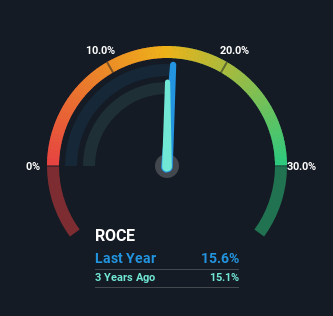- United States
- /
- Professional Services
- /
- NYSE:MAN
Capital Allocation Trends At ManpowerGroup (NYSE:MAN) Aren't Ideal

When we're researching a company, it's sometimes hard to find the warning signs, but there are some financial metrics that can help spot trouble early. More often than not, we'll see a declining return on capital employed (ROCE) and a declining amount of capital employed. This indicates to us that the business is not only shrinking the size of its net assets, but its returns are falling as well. So after we looked into ManpowerGroup (NYSE:MAN), the trends above didn't look too great.
What Is Return On Capital Employed (ROCE)?
For those that aren't sure what ROCE is, it measures the amount of pre-tax profits a company can generate from the capital employed in its business. The formula for this calculation on ManpowerGroup is:
Return on Capital Employed = Earnings Before Interest and Tax (EBIT) ÷ (Total Assets - Current Liabilities)
0.16 = US$657m ÷ (US$9.1b - US$4.9b) (Based on the trailing twelve months to December 2022).
So, ManpowerGroup has an ROCE of 16%. On its own, that's a standard return, however it's much better than the 12% generated by the Professional Services industry.
See our latest analysis for ManpowerGroup

Above you can see how the current ROCE for ManpowerGroup compares to its prior returns on capital, but there's only so much you can tell from the past. If you'd like to see what analysts are forecasting going forward, you should check out our free report for ManpowerGroup.
How Are Returns Trending?
In terms of ManpowerGroup's historical ROCE movements, the trend doesn't inspire confidence. About five years ago, returns on capital were 20%, however they're now substantially lower than that as we saw above. On top of that, it's worth noting that the amount of capital employed within the business has remained relatively steady. This combination can be indicative of a mature business that still has areas to deploy capital, but the returns received aren't as high due potentially to new competition or smaller margins. If these trends continue, we wouldn't expect ManpowerGroup to turn into a multi-bagger.
On a side note, ManpowerGroup's current liabilities are still rather high at 54% of total assets. This can bring about some risks because the company is basically operating with a rather large reliance on its suppliers or other sorts of short-term creditors. Ideally we'd like to see this reduce as that would mean fewer obligations bearing risks.
In Conclusion...
In summary, it's unfortunate that ManpowerGroup is generating lower returns from the same amount of capital. Investors haven't taken kindly to these developments, since the stock has declined 24% from where it was five years ago. Unless there is a shift to a more positive trajectory in these metrics, we would look elsewhere.
If you'd like to know about the risks facing ManpowerGroup, we've discovered 1 warning sign that you should be aware of.
While ManpowerGroup isn't earning the highest return, check out this free list of companies that are earning high returns on equity with solid balance sheets.
If you're looking to trade ManpowerGroup, open an account with the lowest-cost platform trusted by professionals, Interactive Brokers.
With clients in over 200 countries and territories, and access to 160 markets, IBKR lets you trade stocks, options, futures, forex, bonds and funds from a single integrated account.
Enjoy no hidden fees, no account minimums, and FX conversion rates as low as 0.03%, far better than what most brokers offer.
Sponsored ContentNew: Manage All Your Stock Portfolios in One Place
We've created the ultimate portfolio companion for stock investors, and it's free.
• Connect an unlimited number of Portfolios and see your total in one currency
• Be alerted to new Warning Signs or Risks via email or mobile
• Track the Fair Value of your stocks
Have feedback on this article? Concerned about the content? Get in touch with us directly. Alternatively, email editorial-team (at) simplywallst.com.
This article by Simply Wall St is general in nature. We provide commentary based on historical data and analyst forecasts only using an unbiased methodology and our articles are not intended to be financial advice. It does not constitute a recommendation to buy or sell any stock, and does not take account of your objectives, or your financial situation. We aim to bring you long-term focused analysis driven by fundamental data. Note that our analysis may not factor in the latest price-sensitive company announcements or qualitative material. Simply Wall St has no position in any stocks mentioned.
About NYSE:MAN
ManpowerGroup
Provides workforce solutions and services under the Talent Solutions, Manpower, and Experis brands worldwide.
Undervalued with excellent balance sheet and pays a dividend.
Similar Companies
Market Insights
Community Narratives



